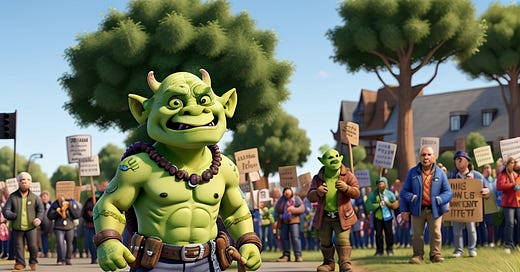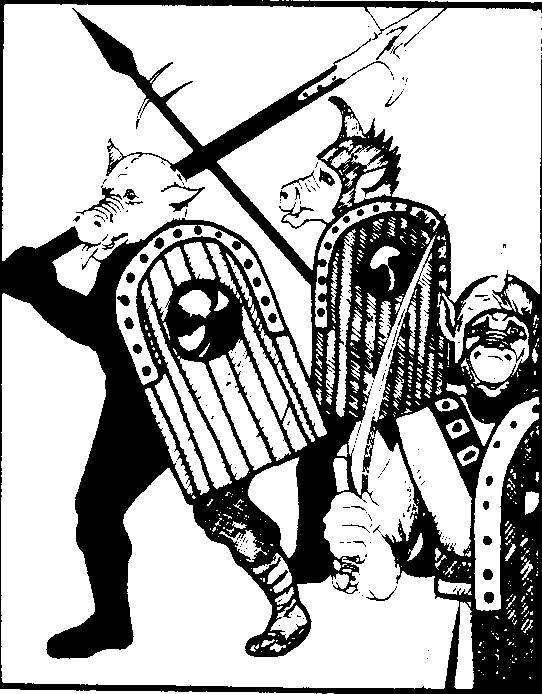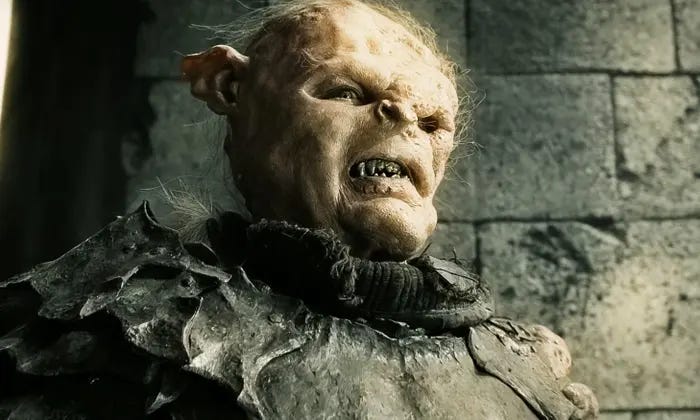Are Visual Depictions of Orcs Based in Racist Stereotypes?
We've incentivized people to problematize things without evidence...so here is some!
Parallel to culture wars in politics and academia, role-playing games such as Dungeons and Dragons (D&D) have been experiencing their own race moral panic in recent years. Activists have complained D&D needs a racial reckoning, due to perceived use of stereotypes in depictions of monster races. Last year D&D removed half-races such as half-elves or half-orcs from the game as “inherently racist” without explaining why (the decision appears to be in response to sensitivity readers’ comments). As one D&D blogger noted, the implications of this comment for real-life mixed-race people is itself controversial. In one 2020 public statement, at the height of the 2020 race panic, Wizards of the Coast (WotC), the company which makes D&D, promised to stop portraying monster races as evil. They claimed their depictions of monster races “…are painfully reminiscent of how real-world ethnic groups have been and continue to be denigrated.” But is that true?
At this juncture, I think we can safely say that in 2020 lots of people said lots of things. This was not because the claims of racism were true or even because people making those claims believed them, but because “being on the right side of history” was necessary for survival, particularly in left spaces. As with most publishing, D&D is definitely a left-leaning space, even if players are politically diverse.
Like many moral beliefs, the concern that visual depictions of D&D monsters were based on racial stereotypes is often accepted prima facie. This is particularly true for progressives for whom such beliefs are an essential part of group identity. Indeed, entire academic fields including games studies appear to have adopted problematizing as an integral scholarly endeavor (games studies’ parent field of communication is among the most liberal/progressive even for academia). The essence of problematizing is to identify something…anything…in media as bad and harmful for some allegedly minoritized group. By doing so, one is cast on the good side. The scholar is good for finding bad media and pointing it out as problematic. So long as this is rewarded…with degrees, jobs, tenure, etc., students and scholars will keep doing it, no matter how non-rigorous such practices may be.
But the question is…does the data support this claim?
To the issue of whether visual depictions of orcs rely on racist stereotypes, I thought it might be valuable to actually study visual depictions of orcs in D&D and the Lord of the Rings movies, both from the 70s-80s and the Peter Jackson movies. Orcs are the bad guys in the Lord of the Rings movies and probably one of the most iconic monsters in D&D. They have historically been at the center of race debates in D&D. So, have visual depictions of orcs relied on racist stereotypes?
First, it helps to be clear what constitutes visual racial stereotypes. Fortunately, there’s a lot of good literature on that. The concern about evil orcs being racist has focused, perhaps confusedly, on both Asian and African stereotypes. African racial visual stereotypes include depictions such as exaggerated red lips, bulging, wide eyes, childish clothing, chalky black skin and wide grins, often exaggerating both the exoticness but also the supposed simple childishness of African people. By contrast, Asian stereotypes often focused on their sneakiness with depictions involving the queue hairstyle, baggy, flowing clothes, exaggerated “slit” eyes, bucked teeth, and yellow skin.
In defense of “problematizing”, negative visual stereotypes of both Africans and Asians were a historical reality. One can simply do an internet search for “racist cartoon” to find multiple examples that are not only offensive today but were obviously cruel jokes even for their own time. And the internet being a dark, ugly place, plenty of ugly memes continue to perpetuate, the main innovation being adding racist stereotypes of Latinos and even whites into the mix.
But the question is whether depiction of orcs in D&D or LotR used visual stereotypes. To do that, in a new study, I examined 30 images from various editions of the D&D system (1st edition through 5th, ranging from the late 1970s though the present), 18 images from the LotR cartoon/rotoscoped movies from the 1970s/1980s and 30 still images from the Peter Jackson LotR movies. These were the product of a Google image search, including all such official images found. I examined the images for the skin color they portrayed, each of the stereotype depictions I mentioned earlier for Africans and Asians, as well as the historical type of armor the orcs appeared to be wearing, if any (European, African, or Asian).
The good news was that, even as far back as the 1970s, neither D&D nor movie depictions of orcs relied on racist stereotypes. Early D&D images tended to portray orcs as having pig-snout like faces and wearing typically European armor. Across D&D and LotR, for skin color, grey was the most common (30%) followed by black-and-white images for which skin color couldn’t be determined (15%) particularly from early D&D versions. This was followed by black (12.8%), green (11.9%), white (9%), brown (9%), blue (5.1%), orange (3.8%), yellow (1.3%) and red (1.3%).
Early LotR movies tended to depict orcs either as vague, shadowy creatures with few discernible human features (particularly the 1970s rotoscope film), or as grey toad-like creatures (the cartoon Return of the King movie). Peter Jackson orcs tended to be grey, or pale skinned aside from the bigger Uruk Hai who tended to be darker skinned. Most armor depictions were simply historically unidentifiable, either involving rusted, broken, or incomplete armor or odd spiked armor no major historical culture commonly wore. When armor was identifiable, it was most commonly European style (39.7%) followed by Asiatic (1.3%).
Negative racial stereotypes were seldom used in visual depictions of orcs and, where they did occur, never in combination as one might expect if there was intent to evoke either Asian or African stereotypes. For instance, some D&D orcs (13.3%) did have queue-like ponytails, but not in combination with other Asiatic stereotypes. Thus, these are likely chance occurrences intended to give the orcs a martial look, but without evoking explicit racism.
If racial stereotypes are so rare, why do some people insist they’re common, and why did the D&D development team even go along with this belief? I believe there are several processes in play.
First, and perhaps the least generous possibility, in a traditional Rorschach-like fashion, some individuals may be projecting their own racism onto fairly neutral stimuli. If one looks at an image of a monster and thinks to themselves “That reminds me of a black person!” the problem may be more with that person than the drawing of the orc. But, in the modern US, UK and elsewhere, holding such opinions is explicitly taboo and vanishingly rare. Sensing even a moment of ugly thought can be shame inducing…and what better way to reduce one’s shame than to project it onto others? Indeed, a whole DEI industry of projected self-flagellation such as Robin DiAngelo’s White Fragility (which I’ve read, as well as its sequel so you don’t have to) has sprung up to meet this need. Do I believe DiAngelo is a racist of the old school? Sure. But that doesn’t mean everyone else is, however much she wants to believe that.
I suspect many critics of D&D and LotR orcs are doing the same thing…their own ugly thoughts become morally virtuous once turned into a crusade. But we’d all be better off if those individuals would do some internal soul searching instead of assuming the rest of the world is molded in their own image.
Second, as I’ve alluded to before, problematizing things is rewarded. This is particularly true for some academic fields which seem outright obsessed with problematization. Again, some things really are offensive and ugly but, as with anything, once a process becomes rewarded without any restraint, we’ll see corresponding behaviors increase in frequency far past the rational. If one is inclined to look for racism, with a modicum of creativity it’s possible to declare anything racist. Hence, in the heady days of the late 2010s and early 2020s, we saw a bevy of news and scholarly articles declaring everything from being on time, to getting the right answer in math, to hiking, to nutrition, to skiing, to dogs, to physics, to Dr. Seuss, to photography, to swimming (and apparently drowning) to fishing, etc., etc. to be racist. Fortunately, the appetite for these seems to have declined as people called out the absurdity of the fairly obvious ragebaiting of “X is White Supremacy” headlines.
But this culture still exists in much of academia where students and faculty continue to be rewarded for sprinkling problematizing, decolonizing, and claims of oppression into their work. Further, once someone loudly declares to have seen systemic racism (or other isms) somewhere, onlookers must decide for themselves whether it is worth challenging the declaration, lest they themselves be declared racist for not towing the party line.
Which brings me to WotC…why have they thrown their own product under the bus? In part this is because WotC are not the original makers of D&D and the original designer, Gary Gygax is long dead and (like Tolkien) can’t defend his work. But also, in the right environment, the confessional brings influence and status. This is the same as how it works in some religions. I remember once attending a conservative sermon where the gentleman on stage loudly confessed his prior life of wicked sexual promiscuity. I remember thinking, “This dude?” Not to be mean but he was neither physically nor in terms of charm the sort of fellow women fall all over themselves after (I make no such claim for myself either, so my intention here is not to be unkind). Of course, who knows, but my point is when public confessions are equated with status and power people will make stuff up, because that’s what people do to get status and power.
Related to WotC do they really believe their product, whether in the past or present, is shot through with white supremacy? Who knows…people can convince themselves of a lot of things when they think it’s in their interest to do so. And I suspect, like a lot of people in 2020, WotC misread the tea leaves and thought that going on a highly visible campaign of “anti-racism” (a more ironic term is hard to think of) was going to help them sell product. Once out on the limb it’s hard to walk that back even as one comes to the realization most of one’s core audience is eyerolling at best.
Like so many in politics, news media, and academia, WotC mistook the caterwauling of the neurotic few for a sea change in public opinion (Black Lives Matter is currently underwater in opinion polls). They assumed that the loudest voices claiming to speak on behalf of racial minorities really were doing so when, in fact, they mostly were promoting their own moral and professional clout. It turns out, most black, Latino and Asian people couldn’t care less about evil orcs.
To be clear: no, D&D and LotR aren’t rooted in racist stereotypes and never were. WotC made a horrendous mistake in catering to a bad social movement. What impact this will have on their customer base in years to come remains to be seen.







